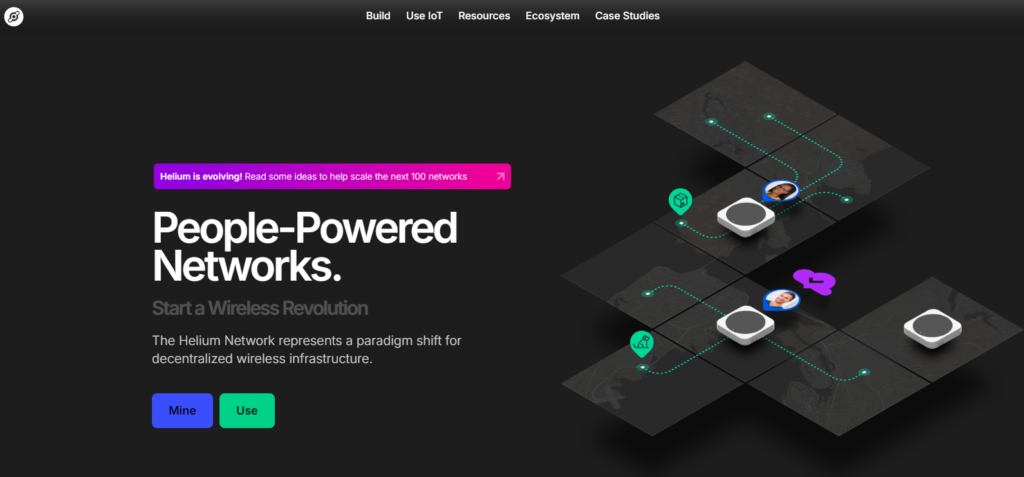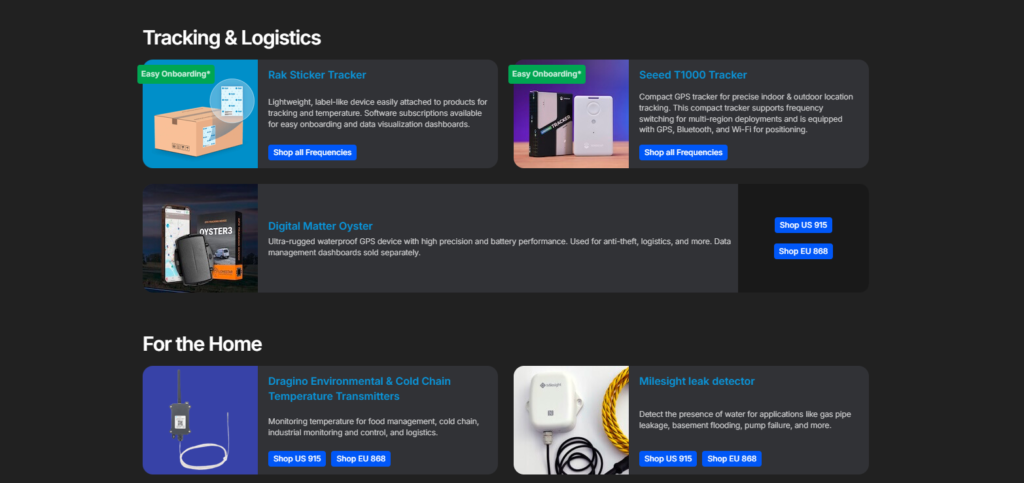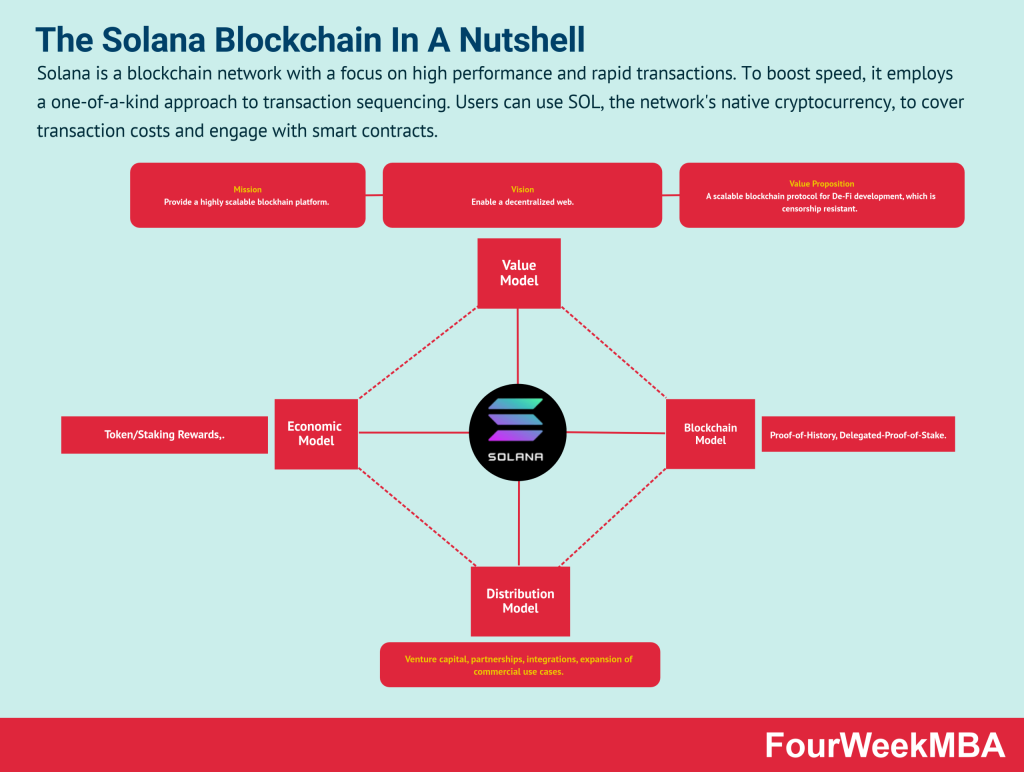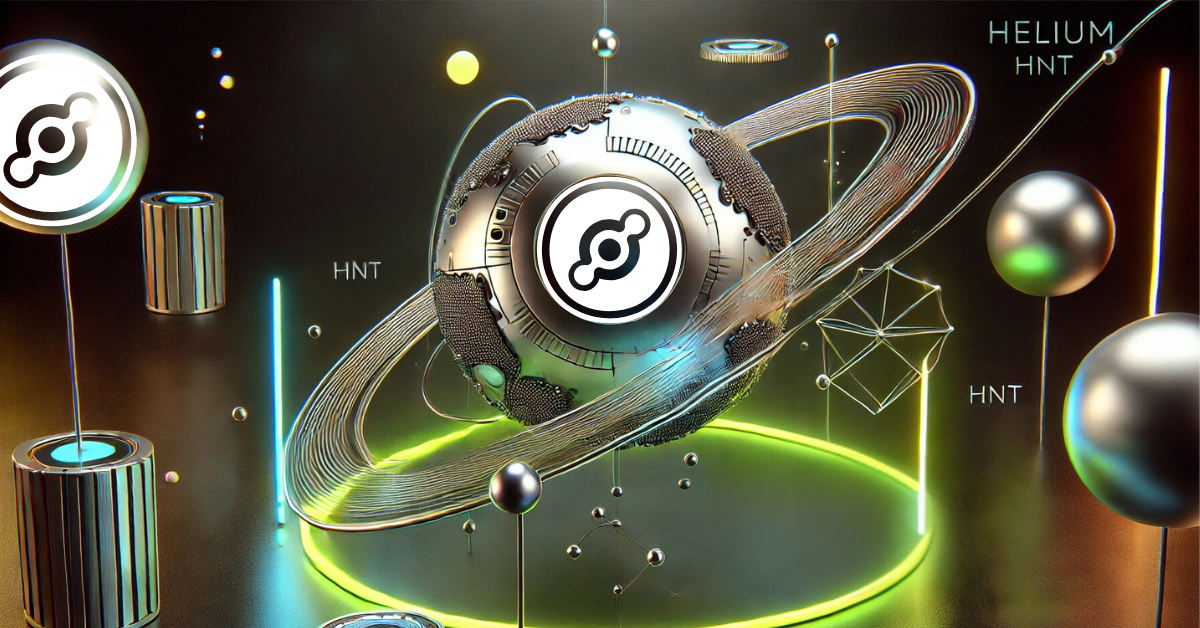The Internet is the bread and butter of the modern world. It has brought many changes to the way we interact with everything ranging from our personal lives to corporate and professional needs. Given the internet usability, Helium (HNT) has paved the way for a more convenient way for the productivity of the internet.
According to a report on Statista, approximately 5.45 billion of the global population are internet users. This staggering number gives an idea for the merger of blockchain technology with the Internet of Things (IoT) or devices on the Internet. Blockchain, itself, is the product of the internet. However, Helium has enhanced the utility of the blockchain with its application in IoT.
But, what is Helium (HNT)? How does the Helium Network revolutionize wireless connectivity? Helium is a blockchain-based cellular network with a faster internet connection and complete decentralization.
We will elaborate on the Helium network in this article by covering the following aspects of this decentralized wireless network:
- What is the Helium network?
- Working of Helium
- Uniqueness of Helium network
- Helium token (HNT) tokenomics
- Pros and cons of Helium
Read on to learn everything about Helium to contribute to the future of a powerful and decentralized internet.
Discover the Telegram-based earning game Notcoin here.
Helium (HNT) Explained

Decentralization is a powerful technological solution with several real-world applications. Thanks to blockchain technology, decentralized blockchain-based applications offer complete ownership and control to the owners and authors of digital products and services.
Helium is one of the best applications of decentralized blockchain technology in the Internet of Things (IoT) industry. There are several internet service providers that are top-notch when it comes to offering cellular networks. However, higher prices, privacy, and vulnerabilities are some of their drawbacks.
This is when the role of a revolutionary decentralized solution, Helium Network, comes into the show. A valuable addition to the wireless infrastructure, Helium (HNT) solves the issues of affordability and security. It is an open-source network with distributed hotspots that offers 5G connectivity.
We will cover how it works and how you can benefit from Helium in the coming sections of this guide. Be mindful that Helium is a blockchain at its core and it has a native cryptocurrency token, known as Helium token (HNT).
How Does Helium Work?
Before discussing how this decentralized wireless network works, it is imperative to understand the Internet of Things. As the term ‘Internet’ refers to the interconnectivity and the mutual connection between different things or devices, the Internet of Things implies the link and communication between things or devices.
IoT is a widespread industry with millions of devices worldwide. This includes smart gadgets, home products, and more. As per Statista, the global IoT annual revenue will reach up to $445.3 billion in 2025. Thus, Helium is a lucrative technology that incentivizes or rewards the use of its IoT solutions.
Helium works using Helium Hotspots. A hotspot is a node or wireless device that offers connectivity between devices and objects on the internet. You can connect a single hotspot to hundreds of devices without giving up the bandwidth and speed of the connection. The faster speed is due to the Long-Range Wide Area Network (LoRaWAN) protocol.
Additionally, connectivity of more devices over a single connection means vulnerable privacy. Helium rectifies this issue via the Proof of Coverage (PoC) consensus mechanism. The PoC mechanism effectively distributes functionality among Helium token holders and node operators, creating different roles. That includes:
- Challenger
- Challengee
- And Witness
The Story Behind Helium’s Birth

Back in 2013 when the internet of things was not really a big deal, some computer nerds forecasted a future of smart gadgets and devices. They realized that connectivity comes at a higher price with a compromised speed. Thus, they launched Helium Inc., in 2013.
Despite their futuristic idea, Aamir Halim and Shawn Fanning couldn’t build a widespread community of users for over six years. At that time, the cryptocurrency factor was not there with Helium. They introduced the cryptocurrency reward mechanism in 2019 by rewarding the use and installing Helium Hotspots for IoT devices.
The blockchain-based idea not only boosted the project’s global reach but also solved the privacy concerns associated with higher connections over a network. Up to date, many companies and businesses rely on Helium wireless infrastructure to elevate the functionality of their IoT devices.
Explore the future of decentralized AI by reading about AgentLayer.
Helium Ecosystem – The Tech Stack Fueling the IoT Infrastructure
As of now, almost everyone is aware of the financial incentive of the cryptocurrency ecosystem. In other words, you will be familiar with the monetary benefits and use cases of cryptocurrency, such as crypto trading, investing, staking, scalping, and the payment system. However, cryptocurrency has other benefits as well.
Helium is one such example as it uses Helium crypto (HNT) to strengthen and revolutionize its business model as well as reward Hotspot users with HNT. HNT token drives multiple uses, such as deploying Hotspots, maintaining the Helium Network, and the complete operation of the connections.
These are possible due to the fully functional ecosystem of the Helium network. Here is what the Helium infrastructure looks like:
Helium’s Blockchain – The Solana Blockchain

Helium is not just a wireless infrastructure but a developer playground. We have talked about the open-source blockchain nature of Helium, and the use of that is the capacity that Helium technology offers to anyone who wants to create a wireless solution. Due to its peer-to-peer wireless network, it is the top priority for IoT developers worldwide.
The core technology of Helium is its blockchain network. It is built on top of the Solana blockchain. Solana, which is known as the Ethereum killer, is a blockchain network that also takes the internet to the next level. It aims to offer internet for everyone, creating a perfect backbone for the Helium network to leverage its operation.
Helium uses the Solana blockchain with several tweaks and improvements to empower the incentivization of using HNT tokens. This blockchain also brings security and safety of privacy to the table against malicious actors and scammers. Thus, Helium users enjoy safeguarded connectivity of their devices.
What is the role of DAI in DeFi ecosystem?
Proof of Coverage Consensus Mechanism
The consensus mechanism is an algorithm that works automatically on a programmed codebase for the verification of the incoming data. Since Helium offers a distinctive functionality in the IoT landscape, it introduced a new algorithm for the consensus of its operation, known as Proof-of-Coverage (PoC).
PoC ensures reliable coverage which is important for a cheaper connection with faster speed. The PoC consensus mechanism works on the inevitable properties of radio frequencies of a connection. The Radio Frequency (RF) transfer in a limited distance or area of coverage. The distance of the signal transmitter inversely affects the intensity of the radio frequency.
The data that RF provides the Helium blockchain will help the PoC consensus mechanism a way to validate the working of the Helium Hotspots or connected devices. You can understand the whole PoC mechanism with the following roles:
- Challenger: It is the transmitter of the radio frequency to validate the strength of signals (Challenge)
- Challengee: It is the Helium Hotspot, which is the target of the challenge. The challenge is the validation of radio signals.
- Witness: It functions to validate the process and send the data back to the blockchain for connection maintenance.
LoRaWAN Protocol

LoRaWAN is the protocol that powers the higher speed of the Helium network. This protocol and the Helium blockchain are collectively named Helium LongFi. Helium LongFi brings LoRaWAN technology to the table to ensure that any device with the LoRaWAN wireless protocol can communicate effortlessly with Helium Hotspots.
What is LoRaWAN? When you are reading this guide about Helium Network on the internet, have you ever thought about what makes the connection between the device you’re viewing this article on and the server where we published this website? If your answer is the Wi-Fi or the cellular data, the question is how. Simply, it is a network protocol.
LoRaWAN is one of those protocols that connect devices and things to the internet. It stands for Low Range Wide Area Network, which is a low-power and wide-area protocol for wireless communication between devices and servers regionally and globally.
Helium Hotspot
We have already discussed Helium Hotspot as of now. A Helium Hotspot is a physical device that offers dual functionality to Helium users. That includes:
- Mining Helium token (HNT)
- A radio connection to the Helium network
The best thing about Helium Hotspot is its minimal costs, allowing anyone to get a gateway for connecting their IoT devices with the network. When you want to make a connection between your electronic bike or any other IoT device with the internet, you will need to set up a physical Helium Hotspot to do so. You might be thinking, how does it differ from my Wi-Fi router or modem. The answer is the range of the connection, which is elongated and extensive for Helium Hotspots compared to traditional routers.
Due to its beneficial functionality, there are a total of 1,010,711 hotspots installed as of now. Most IoT companies are spending on Helium technology to empower their consumers with top-notch connectivity.
Learn about the top 10 crypto exchanges for mobile devices.
WHIP
Now, there are hundreds and thousands of Helium Hotspots installed at various locations. How can you locate the locality of a Hotspot? WHIP is another open-source network protocol of Helium that offers details about the positions of Hotspots.
The best thing about WHIP is its design which covers locations of hotspots in a wide range of areas. Additionally, it doesn’t require you to buy proprietary technologies or modulation solutions to run WHIP. It automatically acquires the existing commodity radio chips to function properly.
WHIP uses the proof of location for this pursuit. This cuts the need for costly satellite location hardware. The proof of location protocol stores the immutable and validated data about the Helium Hotpots in the Helium blockchain for higher transparency and audit.
Key Features of Helium Network
Helium Network is unique in certain functionalities. Unlike other blockchains that solely rely on the decentralization of software, Helium brings censorship resistance for software as well as hardware. Thus, this defies any monopoly that can exist in the IoT ecosystem. Consequently, Helium is the People’s Network.
Furthermore, the proof of coverage model in combination with Honey Badger Byzantine Fault Tolerance (HBBFT) levels up the working of the Helium Network. The HBBFT protocol is vital in the proper and effective functioning of the network even if there occurs failure in several nodes or Helium Hotspots.
Besides, the Helium Protocol has numerous features that make it the top choice for IoT companies, consumers, developers, and more. They are as follows:
1. HNT Token

The Helium (HNT) token is like the nits and grits of the Helium infrastructure and its financial model. It is the method that has earned Helium millions of users worldwide, as we have already stated in the History section of this guide.
It’s the method to incentivize and reward Helium users. Furthermore, it has the functionality of keeping the network secure, and allowing for democratic governance. This allows HNT holders to propose changes and improvements in the Helium blockchain based on votes.
Typically, Helium allows its users to earn HNT tokens in two different manners. That includes:
Firstly through the proof of coverage mechanism. Hotspot operators earn HNT crypto by showing they’re providing legit wireless coverage. In other words, they verify and validate the location and status of Hotspots and reward those who offer steady and reliable coverage.
Likewise, users can earn HNT via the data transfer method. This means that the more a Hotspot transfers data, the more will be the HNT rewards. Simply put, each time a connected IoT device sends or receives data through a Hotspot, the operator earns HNT tokens.
2. Data Credits
There is another currency on the Helium network, which is data credits. It is different from HNT tokens in the sense that you can’t transfer this currency or trade with it. You can use this only for the usage of the network.
First you earn HNT that you exchange with data credits for using the Helium services. This process is known as HNT Burning. This is the primary reason for the deflationary nature of the Helium token because there is a burn-and-mint equilibrium.
You will be wondering how this exchange happens. Helium has fixed a certain value for this exchange from HNT to data credits in fiat currency, USD. This function provides consumers with stability against the volatility associated with HNT crypto because the value of HNT may differ as per the demand of the Helium network in the IoT ecosystem.
3. Open-Source and Developer-Friendly
As you read earlier, the Helium network offers support for IoT developers to create solutions, applications, and services on top of the Helium network.
Helium is open-source so that anyone in the public has access to a reliable and affordable development playground for decentralized applications and services. HNT and data credits are your ticket to bring your IoT ideas to life using the Helium platform.
These innovations will not only contribute to the financial well-being of the developers but also the strengthening of the overall IoT infrastructure. This will result in improving various sectors, such as logistics, smart cities, agriculture, and more.
4. Network Scaling through Validator Nodes
Scalability is one of the several features of blockchain technology. It refers to the transfer of data per second. The higher the scalability, the more reliable a technology becomes for the people. Since Helium also functions on top of a blockchain, it offers scalability to businesses and developers.
With proof of coverage algorithms, validator nodes are comfortable and fast to verify the new data. This adds to the fair distribution of the Hotspot data and rewards. Though there must be adequate HNT tokens to run the validator nodes, the incentives Helium offers tackle this concern effortlessly.
Consequently, Hotspots have less load to function faster and more effectively thanks to validator nodes. This makes the Helium network scalable and efficient for developers and IoT devices.
5. Roaming and Interoperability
The partnership and support for LoRaWAN protocols allow seamless connectivity regardless of your location. This adds to the functionality of wireless connection. Furthermore, it cuts the limitation of users from a specific location and position.
With the roaming feature of the Helium network, you can travel freely without worrying about the internet connection. You will still get adequate speed and bandwidth if you find any service provider that supports LoRaWAN protocol in the area you moved to.
Therefore, this feature is a top selling point for freelancers and digital nomads who need an internet connection while they travel.
Helium Crypto (HNT) – The Token of the Modern Internet
The Helium network operates with a native cryptocurrency token, HNT. This token offers several functionalities, including the financial token, governance token, medium of exchange for data credits, and token for trading and investing.
The HNT tokenomics includes the market capitalization and the total supply. According to CoinMarketCap, the total and circulating supply of HNT tokens is 160.87 million. In terms of market value, Helium Network ranks number 60 in the crypto market with a capitalization of 1.08 billion USD.
It is a reliable crypto token that you can consider for trading if you want to leverage the power of crypto volatility. Be mindful that crypto trading may incur a financial loss. Therefore, make sure to do thorough research before diving into the crypto trading journey.
Moreover, data credits are vital in the Helium Network as it is your ticket to use its services. You can buy data credits via credit card or burn your HNT tokens.
What are the best platforms for crypto-based debit cards in 2024?
Perks of Helium Network
Since Helium is also known as People’s Network, it implies that this is built to cover the connectivity requirements of the public. This is done regardless of the location, societal status, and profits. Unfortunately, these are the limitations of conventional internet service providers.
Helium cuts off the following limitations and offers benefits to its users globally.
1. Internet for All
The traditional internet infrastructure is centralized with the control in the hands of a few internet service providers. They control the prices, speed, and quality of the connection, hindering the majority of the population from getting high-quality internet.
Helium resolves this issue with its decentralized and open-source blockchain infrastructure. Anyone can enjoy cost-effective internet connectivity with a longer range and increased speed. It offers the best solution to cut off the need for using cellular data when the Wi-Fi is not around.
The lower cost and enhanced connectivity make it a people’s network. This is due to the incredible business model of Helium and its decentralized system.
2. Cost-Effective and Eco-Friendly
Helium Network offers an economical solution to enterprises and individuals who use the internet. Since Helium doesn’t rely on expensive Graphics Processing Units (GPU) for mining and validation, the prices of using Helium IoT services are lower than conventional solutions.
Furthermore, this method of no GPU usage is the best for environmental well-being. It creates less air pollution as compared to other methods of mining and IoT technologies. Helium is all about small IoT devices, such as e-bikes, smart gadgets, etc. This does not eliminate higher energy to the ecosystem, keeping the environment clean and healthy.
3. Crypto Incentives
Imagine a platform that offers you internet connectivity at an affordable cost and also rewards you with cryptocurrency for using its services. Isn’t this lucrative? Well, the Helium network rewards you with the more data you use on the Helium Hotspot.
Additionally, it doesn’t limit the rewards to a specific group of people. The peer-to-peer model of the Helium blockchain allows anyone who uses the Hotspot to earn an HNT token.
Challenges to Helium
Helium has a long way to go as there are several IoT sharks taking over the market. For instance, Kaa IoT, Zetta, etc., are some top competitors for Helium Network, creating a hindrance in its global adoption.
On top of that, the increased popularity of the Helium Network hsa adversely impacted its efficiency in creating Hotspots. It may take a long time to receive your Hotspot after making a purchase. This way, consumers’ earning gets affected which may drive them to other IoT companies.
Conclusion
Helium is the people-powered network for Internet-of-Things (IoT) connectivity. It aims to bring a paradigm shift in the way people perceive digital transformation. It has merged the functionality of modern technologies, which are IoT and blockchain.
The blockchain offers decentralization and freedom from authorities in owning IoT devices and interconnecting them. Furthermore, it also offers consumers an opportunity for financial freedom via the incentivization model of Helium Network with HNT tokens.
FAQs
How can you mine Helium?
You will need a Helium Hotspot and a power source to start minting HNT tokens. You can connect with Helium Hotspot and validate the connection that leads to creating HNT.
What makes Helium Network unique?
The unique algorithm for validation, the Proof-of-Coverage (PoC) consensus mechanism, makes Helium Network unique. It offers scalability, security, and speed to its operation, making it a top choice for IoT companies.
What is the purpose of Helium Hotspot?
The core purpose of Helium Hotspot is to offer low-power and wide-range internet connectivity to IoT devices.
Does the Helium network have a future?
As the IoT and blockchain evolve, the future of Helium Network seems promising. This network can go booming soon, making its native crypto token, HNT, a hot choice for crypto investors.
Why does Helium use blockchain?
Though it started as a simple IoT company in 2013, Helium started using blockchain technology for widespread adoption and enhanced security. Blockchain offers scalability, interoperability, and security to Helium operations.






